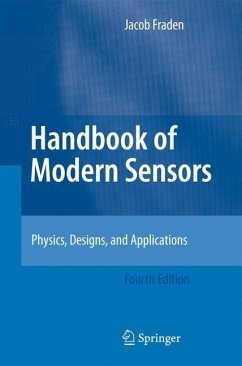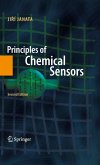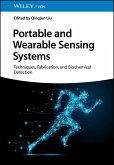Since publication of the previous, the 3rd edition of this book, the sensor tech- logies have made a remarkable leap ahead. The sensitivity of the sensors became higher, the dimensions - smaller, the selectivity - better, and the prices - lower. What have not changed, are the fundamental principles of the sensor design. They still are governed by the laws of Nature. Arguably one of the greatest geniuses ever lived, Leonardo Da Vinci had his own peculiar way of praying. It went like this, "Oh Lord, thanks for Thou don't violate Thy own laws. " It is comforting indeed that the laws of Nature do not change with time, it is just that our appreciation of them becomes re?ned. Thus, this new edition examines the same good old laws of Nature that form the foundation for designs of various sensors. This has not changed much since the previous editions. Yet, the sections that describe practical designs are revised substantially. Recent ideas and developments have been added, while obsoleteand less important designs were dropped. This book is about devices commonly called sensors. The invention of a microprocessor has brought highly sophisticated instruments into our everyday life. Numerous computerized appliances, of which microprocessors are integral parts, wash clothes and prepare coffee, play music, guard homes, and control room temperature. Sensors are essential components in any device that uses a digital signal processor.
From the reviews:
"... A very useful book ... It strikes an excellent balance between a large variety of different sensor types and moderate description of each to yield a book of reasonable length ... Provides excellent information on all types of physical measurements. I recommend it highly." Biomedical Instrumentation & Technology
"Jacob Fraden has produced a valuable, single-volume reference on the devices that bridge the analog and digital worlds." Lawrence Rubin, MIT
From the reviews of the third edition:
"This is a weighty volume of nearly 600 pages. ... The book is undoubtedly useful as a source of reference. The large number of sensors described in it, and the consideration of underlying principles of operation should help people ... ." (Allan Hobson, Robotica, Vol. 23, 2005)
"This book handles the basic and absolutely most important common areas of all sensor applications. It gives a good overview of a very wide rangeof sensor applications, which is not found in many other books in such a detailed form. ... This book is useful for everybody who works with any kind of measurement technique. For beginners it is a good introduction to the world of sensors. For advanced users it is a good and extensive handbook and help." (Rüdiger Frank, Analytical and Bioanalytical Chemistry, Vol. 382, 2005)
"This book ... aims for breadth and to be a reasonably comprehensive account of most modern sensors. ... The Handbook is a readable reference text for researchers, graduate students and engineers ... . Don't read this book if you don't want to know how the sensors work ... . If, however you want to understand how a sensor works, the principle behind it ... or use all that sensors have to offer technically, then this book is for you." (Stephen Kukureka Fimmm, Materials World, Vol. 13 (2), February, 2005)
"Sensors are the eyes, the ears and the noses of the silicium chips. ... The aim of the author is to provide comprehension, samples, general solutions for use, tables of practical data, all in volume. He succeeds to provide an enormous amount of information. ... It's a wonderful illustration of physics. ... a very interesting and good book, useful for experimental physicist or engineer even for theoreticians to see how theory is applied practically. A book to be placed in each laboratory's library." (J-C. Jodogne, Physicalia, Vol. 28 (4-6), 2006)
"... A very useful book ... It strikes an excellent balance between a large variety of different sensor types and moderate description of each to yield a book of reasonable length ... Provides excellent information on all types of physical measurements. I recommend it highly." Biomedical Instrumentation & Technology
"Jacob Fraden has produced a valuable, single-volume reference on the devices that bridge the analog and digital worlds." Lawrence Rubin, MIT
From the reviews of the third edition:
"This is a weighty volume of nearly 600 pages. ... The book is undoubtedly useful as a source of reference. The large number of sensors described in it, and the consideration of underlying principles of operation should help people ... ." (Allan Hobson, Robotica, Vol. 23, 2005)
"This book handles the basic and absolutely most important common areas of all sensor applications. It gives a good overview of a very wide rangeof sensor applications, which is not found in many other books in such a detailed form. ... This book is useful for everybody who works with any kind of measurement technique. For beginners it is a good introduction to the world of sensors. For advanced users it is a good and extensive handbook and help." (Rüdiger Frank, Analytical and Bioanalytical Chemistry, Vol. 382, 2005)
"This book ... aims for breadth and to be a reasonably comprehensive account of most modern sensors. ... The Handbook is a readable reference text for researchers, graduate students and engineers ... . Don't read this book if you don't want to know how the sensors work ... . If, however you want to understand how a sensor works, the principle behind it ... or use all that sensors have to offer technically, then this book is for you." (Stephen Kukureka Fimmm, Materials World, Vol. 13 (2), February, 2005)
"Sensors are the eyes, the ears and the noses of the silicium chips. ... The aim of the author is to provide comprehension, samples, general solutions for use, tables of practical data, all in volume. He succeeds to provide an enormous amount of information. ... It's a wonderful illustration of physics. ... a very interesting and good book, useful for experimental physicist or engineer even for theoreticians to see how theory is applied practically. A book to be placed in each laboratory's library." (J-C. Jodogne, Physicalia, Vol. 28 (4-6), 2006)
Selected by Choice magazine as an "Outstanding Academic Title" for 2016
"Each class of sensors is individually addressed in detail from its basics to modern usage. Besides the physics behind the operation of the sensors, sensor applications and limitations are explained well. ... This clearly written work would be an excellent resource for most technical readers who want to understand, use, and design with sensors. Summing Up: Highly recommended. Upper-division undergraduates through professionals/practitioners; two-year technical program students." (M. Mehrubeoglu, Choice, Vol. 53 (10), June, 2016)
"This book appeared at a time of increasing need for sensor handbooks and is therefore a good choice for students as well as engineers. It presents an overview giving a comprehensive and up-to-date physical principles, design, and practical implementations of various sensors for scientific, industrial, and consumer applications. ... Owing to the amount of content, this is still aworthwhile handbook, which would be interesting for a lot of readers coming from different scientific disciplines." (Gerald Urban, Analytical and Bioanalytical Chemistry, May, 2016)
"Each class of sensors is individually addressed in detail from its basics to modern usage. Besides the physics behind the operation of the sensors, sensor applications and limitations are explained well. ... This clearly written work would be an excellent resource for most technical readers who want to understand, use, and design with sensors. Summing Up: Highly recommended. Upper-division undergraduates through professionals/practitioners; two-year technical program students." (M. Mehrubeoglu, Choice, Vol. 53 (10), June, 2016)
"This book appeared at a time of increasing need for sensor handbooks and is therefore a good choice for students as well as engineers. It presents an overview giving a comprehensive and up-to-date physical principles, design, and practical implementations of various sensors for scientific, industrial, and consumer applications. ... Owing to the amount of content, this is still aworthwhile handbook, which would be interesting for a lot of readers coming from different scientific disciplines." (Gerald Urban, Analytical and Bioanalytical Chemistry, May, 2016)








